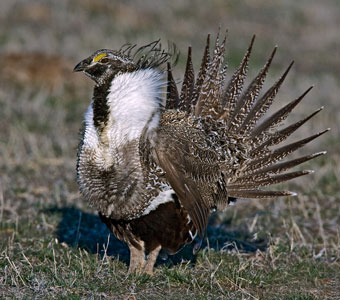

|
Greater Sage-Grouse (Centrocercus urophasianus) 
Description: The Greater Sage-Grouse is a large chicken-like bird found in pen sagebrush plains. Grayish in color with a black belly and long tail, with spiky tail feathers. Females are duller in color and blend in with the surrounding habitat.
Calls:
The call is distinct. 
Range / Habitat: Found in the open sagebrush plains in eastern Washington. This species is uncommon, very local, and declining in sagebrush lands in central Douglas County and in the U.S Army's Yakima Training Center. There are remnant populations in Benton County and Lincoln County, but they are on the verge of extirpation. They were formerly found throughout the lower areas of the Columbia Basin wherever large tracts of sagebrush occurred. Click the range map to learn more about the distribution of Sage-Grouse in Washington. Diet: Their diet includes sagebrush plants and some insects. In the winter, most of the sage grouse's diet is made up of the leaves and shoots of the sagebrush. In the spring, it will also eat weeds and grasses. Nesting: The Greater Sage-Grouse female lays six to nine eggs in a depression in the ground lined with grass. The nest is usually under a bush or other cover to avoid predation. The female incubates the eggs and cares for the chicks who hatch in about three weeks. The little chicks feed on insects for the first few weeks but move on to eat grasses, weeds, and sagebrush. The chicks fledge - leave the nest - in about a week. 
Behavior: During mating season, male sage grouses gather on a lek or a special open display area. While they are on the lek, the males strut around and display their plumage to attract a mate (see photo). Conservation: Sage Grouse Listing Denied: In March 2010 - the US Fish and Wildlife Service announced that the bird warranted listing under the Endangered Species Act, but would be "precluded" by higher priorities - other species that are in greater danger - according to the US Interior Secretary.
Did you know?
Animal silhouettes available to purchase »
Photos: Natures Pics More Information: Greater Sage-Grouse - All About BirdsHome | About Us | How to Participate | Biodiversity Modules | Projects | Maps | News | Resources |